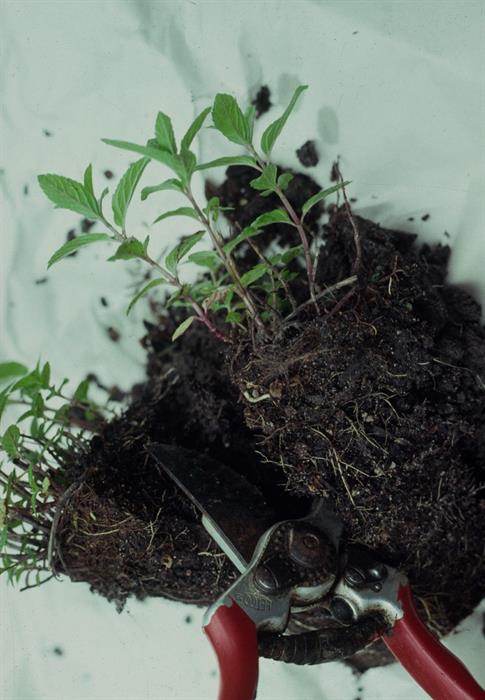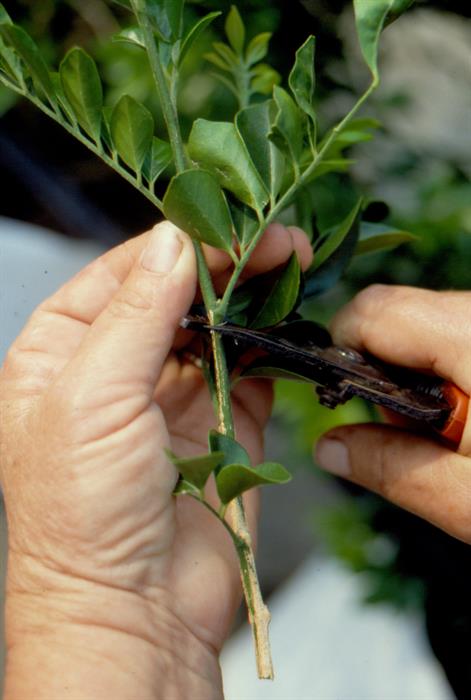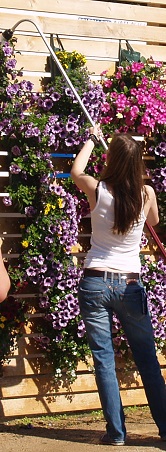COURSE STRUCTURE AND CONTENT
Course Duration: 150 hours.
Start Date: Start at any time - study at a pace that suits you, and with full tutor support for the duration of your studies.
Lessons: The course comprises 10 lessons, covering 4 units:
- The Plant Kingdom (Unit 1)
- Plant Nutrition, The Root Environment (Unit 2)
- Pests, Diseases and Weeds (Unit 3)
- Sexual and Asexual Propagation (Unit 4)
LESSON STRUCTURE
Lesson 1. Classification of Plants and the Plant Naming System
- Botanical and Horticultural Nomenclature: common names, scientific names
- The Binomial System
- Botanical Classification levels
- Horticultural Groups
- Plant Families and their distinguishing characteristics
- Species, Hybrids, Varieties, Cultivars
- Review of significant Dicotyledon and Monocotyledon families
- Plant Life cycles
- Stages in Plant Development
- Plant Collection Reviews
Lesson 2. The Internal Structure of Higher Plants
- Plant Cell Structure
- Cell Components
- Cell Division; mitosis and meiosis
- Types of Plant Cells; Parenchyma, Collechyma,Sclerenchyma, Xylem, Phloem, Epidermal
- Internal Structure of Dicotyledon Stems: Epidermis, endodermis, cortex, vascular bundles, etc.
- Structure of Monocotyledon Stems
- External Differences between Monocotyledons and Dicotyledons
- Anatomical features of leaves and stems in cross section
- Plant Tissues
- Primary and Secondary Growth
- Terminology
- Botanical Keys and their use
Lesson 3. The External Structure of Higher Plants, Roots, Leaves, Stems and Buds
- Stems: the framework, functions of the stem
- Stem modifications
- Leaves
- Functions of leaves
- Respiration, transpiration and photosynthesis
- Leaf shapes
- Compound leaves
- Leaf modifications
- Buds: adventitious, apical, flower, vegetative
- Root Structure
- Types of Root Systems
- Root Modifications
- Morphological Changes due to Maturation
Lesson 4. Identification and Function of the Reproductive Parts of the Plant
- Parts of a flower: Sepals, Petals Stamens, Carpel
- The Inflorescence
- Flower Structure
- Types of Fruits
- Fruit and Seed Terminology
- Modification of Fruits -dry fruits, succulent fruits, composite fruits, false fruits
- Key to Main Fruit Types
Lesson 5. Pollination and Fertilisation in Higher Plants
- Pollination Processes
- Self Pollination, Cross pollination
- Pollination Mechanisms
- Compatibility
- Fertilisation, Embryo and Seed Formation
- Post Fertilisation
- F1 Hybrids
- Genotype versus Phenotype
- Male Sterility
- Parthenocarpy
- Hybrid Seed Production
- Terminology
- Seed and Fruit Development
- Seed Structure
- Seed Germination
- Fruit Set, Growth and Development
Lesson 6. The Fundamental Physiological Processes in Plants, Plant Growth and Developmental Relationships
- Importance of Photosynthesis
- The Light Reactions
- The Dark Reactions
- Chloroplasts in Photosynthesis
- C3, C4 and CAM Plants
- Rate of Photosynthesis
- Chemistry of Respiration
- Rate of Respiration
- Stages of Respiration
- Aerobic versus Anaerobic Respiration
- Transpiration and Translocation of Water
- Osmosis
- Diffusion
- Mechanisms of Nutrient Uptake
- How Water, ions and metabolites move through a plant
- Tropisms; Phototropism, Geotropism, Thigmotropism, etc.
- Chemical Growth Modification; Auxins, Gibberellins, AA, Ethylene, Cytokinin, etc.
- Effects of Chemical hormones
- Light factors in plant growth
- Artificial Light
Lesson 7. Soils and the Root Environment
 Soil Profile
Soil Profile- Importance of Soil
- Soil Composition
- Texture
- Structure and soil types
- Soil Horizons (A, B, C and R)
- Naming the Soil
- Improving Soil Structure
- Soil Sampling
- Improving Fertility
- Organic Matter
- Benefits of adding Organic Matter
- Soil Water and its Value to Plants
- Water Loss from Soils
- Improving Water Retention
- Hygroscopic Water, Gravitational Water, Field Capacity and other terminology
- Saturation
- Rate of Watering
- Plant Health and Drainage
- Symptoms of Poor Drainage Improving surface and sub surface Drainage
- Tensiometer
- Soil pH
- Nutrient Availability and pH
- Calcifuges and Calcicoles
- Adding Lime
- Adding Acidic Materials to Lower pH
- Conservation Issues: Peat
- Terminology
Lesson 8. Plant Nutrition
- Soil Life: Earthworms, Mycorrhyzae, Nitrogen Fixing
- Nitrogen Cycle; Ammonification,Nitrification, Detritrification, Nitrogen Loss
- Forms of Nitrogen
- The Nitrogen Cycle
- The Carbon Cycle
- The Nutrient Elements
- The Major Elements
- The Minor Elements (Trace Elements)
- Total Salts
- Diagnosis of Nutrient Problems
- Fertilisers
- Types of Fertilisers
- Applying Fertilisers
- Natural Fertilisers
- Manures, Rock Dusts, Seaweed
- Composting Methods: sheet composting, Indore method, 14 day method, compost bins, trench composting, etc.
- Green Manures
- Mulch and Mulching
- Cultivation Techniques
- Cultivation Tools and Equipment
- Improving Water Infiltration into Soil
- Non Dig Growing Method
- Soil Problems
- Soil Rehabilitation
- Properties of Growing Media
- Potting Media: Components and mixes
- Choosing Growing Media
- Air Filled Porosity
- Hydroponics defined
Lesson 9. Plant Health Problems
- Factors Affecting Plant Health and Growth
- Types of Problems
- Conducting an Inspection
- Determining and Recommending Treatments
- Responding to Difficult to Diagnose Problems
- Plant Pests - major group
- Pest Treatments - Sanitation, Physical control methods, Resistant varieties
- Biological controls, Chemical controls, Soil drenches
- Insect Biology; structure, life cycles, etc.
- Review of Major Pests and their Treatments
- Review of Major Diseases and their Treatments
- Review of Environmental Problems and their Control
- Types of Weeds
- Identifying Weeds
- Weed Control Methods; suffocation, burning, cultivation, grazing, mowing, solarisation, chemicals, etc.
Lesson 10. Plant Propagation Principles and Practice
- Sexual Propagation
- When to Sow Seed
- Why Some Seeds Don't Germinate
- Dormancy Factors in Seed - Hard Seed Coat, Chemical Inhibitors, Undeveloped Embryos etc.
- Difficult to Germinate Seeds
- Treatments to Break Seed Dormancy
- Seed Sources
- Seed Saving; Seed Storage
- Sowing Seed Indoors
- Seed Sowing: Germination, Temperature Control Hygiene
- Seed Propagating Media
- Sowing Seed Outside
- Handling and caring for Seedlings
- Potting Up
- Propagation after care
- Propagation from Cuttings
- Succeeding with Cuttings
- Types of Cuttings
- Softwood, Semi-Hardwood and Hardwood Cuttings
- Variations on Cuttings: nodal, heel, tip, etc.
- Leaf Cuttings, Leaf bud cuttings, Root Cuttings, Bulb Cuttings, etc.
- Stock Plants for Cuttings
- Layering
- Propagation from Specialised Stems and Roots; Offsets, Division, etc.
- Propagating Tools: Secateurs, How to Cut, Knives
- Grafting
- Propagating Plants in a Greenhouse
- Cold Frames
- Heated Propagators
COURSE AIMS
 Describe the classification of higher plants.
Describe the classification of higher plants.- Describe the internal structure of higher plants.
- Describe the structure and functions of roots, leaves, stems and buds.
- Describe the functions of the reproductive parts of the plant.
- Describe the process of pollination and fertilisation in higher plants.
- Describe the processes photosynthesis, respiration, the movement of water in plants and plant growth and development.
- Develop an understanding of the constituents, properties and management of soils and growing media.
- Describe the nutrient elements and plant nutrition in relation to soil and growing media.
- Describe the uses of organic matter and the importance of living organisms in the soil.
- Develop an understanding of pest, diseases and weeds that affect horticultural plants, and the cultural, biological, chemical and integrated systems used to control those problems.
- Develop an understanding of the principles and main practices of plant propagation in horticulture.
Horticulture is Science and Art - Theory and Practice
To grow plants well you must understand both the theory, and the practical techniques used to put that theory into practice. There are thousands of different plants grown in our gardens; and we need to recognise that every species has it's own peculiar characteristics. Learning to identify different plants and understanding the science that underpins their growth, allows us to may appropriate decisions about how to treat different plants in different places and at different times.
You cannot simply do a weekend short course and expect to be a competent horticulturist, no more than you can do a short medical course and be a competent medical practitioner.
Feeding Plants
Anyone can buy some fertiliser and throw it on plants, but proper plant feeding is more complicated than that.
If you put too much fertiliser, or use the wrong type of fertiliser; a plant may perform worse than it would if it had no fertiliser at all.
You need to understand, plants are often dormant in winter, and don't need any feeding at all. As they burst into spring growth though, they draw heavily on nutrients in the soil. This is when they need the extra nutrients a fertiliser can give.
If inadequate nutrients are present, plant growth becomes stunted. This effect is subtle and not usually noticed until it becomes severe. The nutrient level in the soil may drop as low as 30% below the optimum before deficiency symptoms such as discolouration appear in the leaves. By this time, the overall growth rate and general health of the plant has been affected significantly.
Choose the Right Fertiliser
There is a vast array of fertilisers available and every one is different. Using the wrong fertiliser or the right fertiliser at the wrong rate can create problems in your garden. So how do you choose the right one? For a start, it’s helpful to know what the various fertiliser terms mean:
Complete fertiliser – These contain a mixture of nitrogen, phosphorus and potassium. Some also contain calcium and sulphur, and trace elements. The formulations vary according to the plant groups for which they are designed, e.g. lawns, shrubs, azaleas and camellias. They come in powdered, granular and water-soluble form and are a convenient way to provide plants with all the nutrients they are likely to need.
NPK fertilisers – Another name for ‘complete’ fertilisers (Note: NPK stands for the chemical symbols: Nitrogen, Phosphorus and Potassium; which are the main nutrients a plant needs from a fertiliser).
Water-soluble fertilisers – These are powdered or liquid complete fertilisers that are applied as a dilute solution. They generally have a high nitrogen content and also contain trace elements. They are useful for boosting plant growth but only have a short-term effect.
Slow-release or controlled-release fertilisers – These complete fertilisers are designed to release their nutrients slowly, often up to 12 months. Some are in the form of plant pills, others are covered with a protective coating, eg. Osmocote and Nutricote. They are convenient, safe and easy to use but are more expensive than other NPK fertilisers. Some organic fertilisers such as blood and bone also release nutrients over a long period of time.
Inorganic fertilisers – Artificially-made fertilisers; includes the NPK mixtures.
Organic fertilisers – A broad term for naturally-occurring fertilisers; includes animal manure and animal by-products such as blood and bone, mushroom and other composts, green manures, seaweed and worm casts. The nutrient content is variable, depending on the source of the fertiliser. Some commercially prepared organic fertilisers have known levels of nutrients that are listed on the packet.
When you choose a fertiliser think about the following:
- Convenience and ease of use.
- The type of plants you are fertilising and the time of year.
- The soil type (clay soils hold fertilisers better than sandy soils).
- How quickly you want the plants to grow.
- How much you’re prepared to spend.
- Whether you prefer to rely on organic fertilisers.
Organic v. Inorganic Fertilisers – Which is better?

It makes no difference to the plants whether you apply artificial or organic fertilisers. They simply absorb whatever nutrients are available in the soil.
BUT there are important differences (e.g. the way they work; levels of pollution created in their production; residues on unused by products left behind, etc.).
- Inorganic fertilisers release nutrients quickly, producing rapid plant growth.
- Many inorganic fertilisers can burn plants if applied at high doses.
- Many inorganic fertilisers have a short-term effect and need to be applied frequently to maintain growth.
- Inorganic fertilisers can leave undesirable chemical residues in the soil.
- Most organic fertilisers are safe to use and won’t burn the plants (except some fresh manures which should be aged before use).
- Most organic fertilisers improve the texture and structure of the soil, thereby improving air and water uptake (exceptions are powdered organic fertilisers such as blood and bone).
- Some organic fertilisers don’t contain many nutrients – their main value is as a soil-improver.
How Much Fertiliser Should You Apply?
It is always better to apply too little than too much. You can always add more, but you can't take it out of the soil and put it back in the bag.
Always read the instructions on fertiliser packets. If applying fertiliser to young plants or less hardy plants (e.g. ferns and some indoor plants) you are better to put on less fertiliser.
HOW THE COURSE WORKS
You can start the course at any time.
It is studied by distance learning, so you can study Plant Growth, Propagation and Development in the comfort of your own home. But this doesn't mean you are all alone in your studies. Our highly qualified and friendly tutors are there to help you every step of the way. If you have any questions at all, they are always happy to help.
Each lesson includes set tasks, and is completed with an assignment which the student submits to their course tutor. The tutor will mark the assignment and return this to the student with comments and suggestions for further reading.
WHY CHOOSE ACS?
- Our courses are written and taught by experienced professionals, so you know you can expect a high quality of teaching and support.
- You can start the course at any time and study at your own pace - this is an ideal arrangement for studying Plant Growth, Propagation and Development, allowing you to take a little longer on lessons that particularly interest you or where you wish to invest more time.
- Study where you want to - online studies offer the flexibility for you to determine where and when you study, and around your own arrangements.
START AT ANY TIME
It's easy to enrol - simply go to the enrolment box at the top right-hand side of this page. If you have any QUESTIONS, please do get in touch with our highly knowledgeable Horticulture tutors. They will be happy to help you.